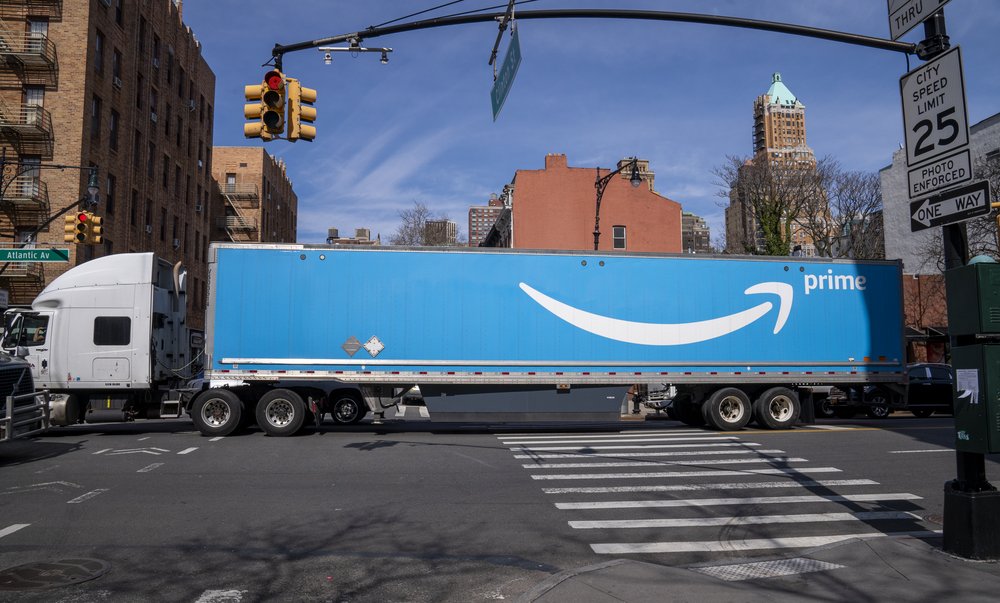More than 1,000 e-commerce trucks rumble through Red Hook each day, damaging the air quality
May 16, 2023, 6:01 a.m.
That’s according to a new investigation by Consumer Reports on the impact of Amazon warehouses and other e-commerce facilities on the Brooklyn neighborhood.

On weekday mornings, heavy delivery trucks trundle down one Red Hook street as often as once every minute. Another spot along the same street can see as many as 1,200 trucks in a single day. That’s according to a new investigation by Consumer Reports on the impact of Amazon warehouses and other e-commerce facilities on the Brooklyn neighborhood.
Working with community members, the investigators placed traffic cameras, air quality sensors and noise-level meters on rooftops and balconies to gauge the health and safety risks of delivery truck traffic. They collected data from last September up through April, then studied it for trends.
They found that truck routes to and from the neighborhood’s half-dozen current and future e-commerce warehouses bordered schools, parks and the Red Hook Houses, the city’s largest New York City Housing Authority complex — and that air pollution in those areas routinely crosses the Environmental Protection Agency’s threshold for unsafe conditions for vulnerable people.
“No one’s surprised the traffic numbers are high or that air quality is a certain way,” said Kaveh Waddell, deputy editor for Consumer Reports’s Digital Lab, who led the investigation. “But being able to say something about the frequency or the volume of some of these dynamics makes a difference.”
Air quality has improved citywide in the last decade, according to data collected by the health department. But NYC’s official network of air quality sensors excludes Red Hook, a mostly Black and Latino neighborhood with a poverty level more than double the citywide tally, according to Census data.
Red Hook has a long history of environmental injustices, linked to its industrial past and coastal location. It was hit hard by Hurricane Sandy, and most of its local sports complex was shuttered in 2021 due to lead contamination. Numerous e-commerce warehouses have popped up there in recent years, including two Amazon facilities currently in operation. A third, slated to open in September, could add more than 1,300 additional truck trips in the neighborhood every weekday, according to Waddell.
To fill the gap in the city’s sensor network, Waddell and his team posted traffic counters and air quality monitors at three locations around Red Hook, including on the roof of a record store and on a volunteer’s balcony across from the NYCHA complex. The team also rigged up a sound monitor at the record store location.
The sensors were installed well after the Amazon warehouses opened for business, so it’s impossible to know how much of the noise and air pollution can be directly attributed to the e-commerce boom, Waddell said. But the data did show how traffic patterns evolved over the course of each day.
The two sensors on Van Brunt Street, a popular shopping strip that also doubles as a truck route, showed a spike in truck and van traffic between 10 a.m. and noon. The busier of the two locations could record as many as 140 trucks per hour. The sensor across from the Red Hook Houses, meanwhile, recorded a steady hum of trucks and vans during business hours — about one every other minute.
The trucks made themselves seen and heard, according to the report’s authors. The sound sensor posted outside the record shop detected regular audio incursions above the usual din of city life — about one every three minutes, according to the report.
Waddell and his colleagues are making the data publicly available, so that residents can use it to lobby for new rules that will stop them from bearing the brunt of e-commerce related air pollution. A few policy proposals are already being considered, including permit requirements for warehouses over a certain size, restrictions on where the facilities can be built and even some lower-emissions “last mile” alternatives, like cargo bikes and marine deliveries.
The city is also working on a traffic study in the neighborhood, and the State Assembly is considering a bill that would establish e-commerce warehouses as an “indirect source” of air pollution thanks to all the truck traffic that surrounds them.
How to find affordable therapy in New York City 230K birds die annually by smashing into NYC windows. A new bill aims to save them.